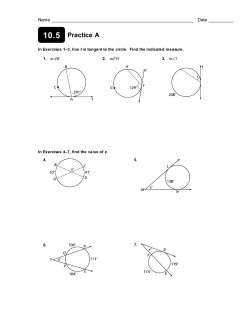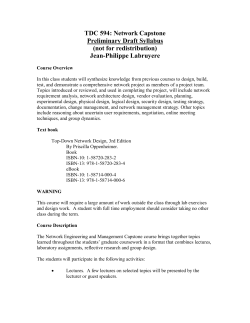
Homework AssignmentsâDigital Signal Processing Semester II
Homework Assignments—Digital Signal Processing
Semester II
Spring 2015
• Homeworks are due one week after they are assigned.
• All References are to S. Engelberg, Digital Signal Processing: An Experimental Approach, Springer, 2008, unless otherwise indicated.
1. (Assigned 3 March 2015) Please perform exercises 1 – 3 and 5 of Chapter 1. Additionally, please perform the following exercises. (You may
want to look at the first of the MATLAB scripts on
http://homedir.jct.ac.il/~shlomoe/Public/dsp_matlab.html before performing the MATLAB part of the exercise.)
(a) Assume one has obeyed the Nyquist criterion (that B < Fs /2),
that Fs = 100 Samp/s, and that the samples of the input are
(
vin (kTs ) =
1 k = −1, 0, 1
.
0 otherwise
i. What was vin (t)?
ii. Plot vin (t) using MATLAB, and submit the program and the
plot with your assignment. (Plot the function for t ∈ [−1, 1].)
(b)
i. If one uses an ideal sampler to sample the signal g(t) =
sin(2π90t) every 10 ms, and one passes the resulting train of
delta function through an ideal low-pass filter whose cutoff
frequency is 50 Hz and whose amplitude is 0.01, what will the
output of the filter be? Explain!
ii. What is this phenomenon called?
2. (Assigned 10 March 2015) Please perform exercise 4 of Chapter 1, exercises 2, 4, and 5 of Chapter 3, and the following exercise. (Note that
inequality (3.1) is just the “uncertainty principle” that we proved in
class.)
(a) Consider a system that samples g(t) every Ts = 0.5 ms.
1
i. Show that any signal, g(t), for which G(f ) = 0 for all |f | ≥
3, 000 and for all |f | ≤ 2, 000 can be reconstructed from the
samples taken by the system. (That is, show that one can
undersample g(t) and still recover g(t) from the samples.)
ii. Find the frequency response of the reconstruction filter, H(f ).
iii. Find the impulse response of the reconstruction filter, h(t).
iv. Find the formula that reconstructs g(t) from its samples,
g(kTs ), and from a knowlege of h(t).
v. Assume that satisfies G(f ) = 0 for all |f | ≥ 3, 000 and for all
|f | ≤ 2, 000 and that
1
2
g(kTs ) =
1
0
k = −1
k=0
.
k = +1
otherwise
What is the reconstructed function g(t)?
vi. Use MATLAB to plot the reconstructed function, g(t), over
the region t ∈ [−0.01, 0.01].
3. (Assigned 24 March 2015) Please perform exercises 1, 3, and 4 of Chapter 4 and the following exercise. (In question 3 of Chapter 4, the method
of sections 4.4 and 4.5 is the Cooley-Tukey FFT that we studied in
class.)
(a) Please use the methods of Sections 4.4 and 4.5 to find the DFTs of
the following sequences. For each DFT, check that the results are
consistent with Parseval’s theorem and that each DFT satisfies
YN −m = Y m .
i. {1, −1, 1, −1, 1, −1, 1, −1}
ii. {1, 2, 1, −2, 1, 2, 1, −2}
4. (Assigned 16 April 2015) Please perform exercises 5, 6, and 9 of Chapter
4 and the following problem. You may want to look at the examples
on pp. 38, 39 and 41 of the text before performing these exercises.
Also, when defining the vector of frequencies, it is helpful to recall that
the frequencies for which the DFT estimates the Fourier transform are
(in a form that is almost suitable for use in MATLAB code) f = [0 :
N − 1] ∗ Fs /N .
2
(a) Please use the Cooley-Tukey FFT to find the DFT of the following
sequence. Check that the results are consistent with Parseval’s
theorem and that the DFT satisfies YN −m = Y m .
i. {−1, 1, 1, −1, 1, 1, −1, 1, 1}
5. (Assigned 21 April 2015) Please perform exercises 7 and 8 of Chapter
4 and exercises 1, 3, 4, and 5 of Chapter 5.
6. (Assigned 29 April 2015) Please perform exercise 5 of Chapter 7 and
exercises 1, 4, 5, 6, and 12 of Chapter 18.
7. (Assigned 5 May 2015) Please perform exercises 8, 9, 10, 13, and 14 of
Chapter 18.
8. (Assigned 12 May 2015) Please perform exercise 11 of Chapter 18,
exercises 1 – 3 of Chapter 19, exercises 2 and 3 of Chapter 20, exercises
1 and 2ab of Chapter 21, and the following exercise.
(a) Let {hk } be the impulse response of a stable filter. Show that if
for all k it is true that hk ≥ 0, then
H(e2πjF Ts )
≤ |H(0)|.
That is, show that H(z) corresponds to a low-pass filter.
9. (Assigned 19 May 2015) Please perform exercises 1 and 4 of Chapter
22 and exercise 1 of Chapter 23. (You may use the bodemag command to examine the magnitude response in exercise 4 of Chapter 22.)
Additionally, please perform the following exercise.
(a) Calculate the transfer function, HC (s), of a second order Chebyshev filter whose cut-off frequency is ωc = 100 and for which the
minimum value of |HC (e2πjf Ts )|2 in the filter’s pass-band is 1/1.01.
10. (Assigned 26 May 2015) Please perform exercise 6 of Chapter 23.
11. (Assigned 9 June 2015) Please perform exercises 3 – 5 of Chapter 24
(but in sections a and b of exercise 4, use prewarping to design the lowpass filter that will be used in the design of the final high-pass filter)
and exercise 1 of Chapter 25.
3
12. (Assigned 16 June 2015) Please perform exercises 3 and 4 of Chapter 25
(but in 4d, do not give a schematic drawing – just give the two transfer
functions, H1 (z) and H2 (z)) and exercises 1 and 2 of Chapter 27.
13. (Assigned 25 June 2015) Please perform exercises 1, 2ab, and 3 of
Chapter 28 and the following exercise.
(a)
i. Design a 401 tap (causal) symmetric low-pass FIR filter for
which Ts = 1 µs and whose cutoff frequency is 5 kHz.
ii. What is the filter’s transfer function, H(z)?
iii. What is the filter’s impulse response, hk ?
iv. Have MATLAB calculate and plot the Bode plots that correspond to this filter.
v. Is 401 taps a reasonable number of taps for this filter? Explain.
Please note that in the context of digital filters, “tap” is a synonym
of “coefficient.”
Last updated at 1:30 on June 25, 2015.
4
© Copyright 2025









